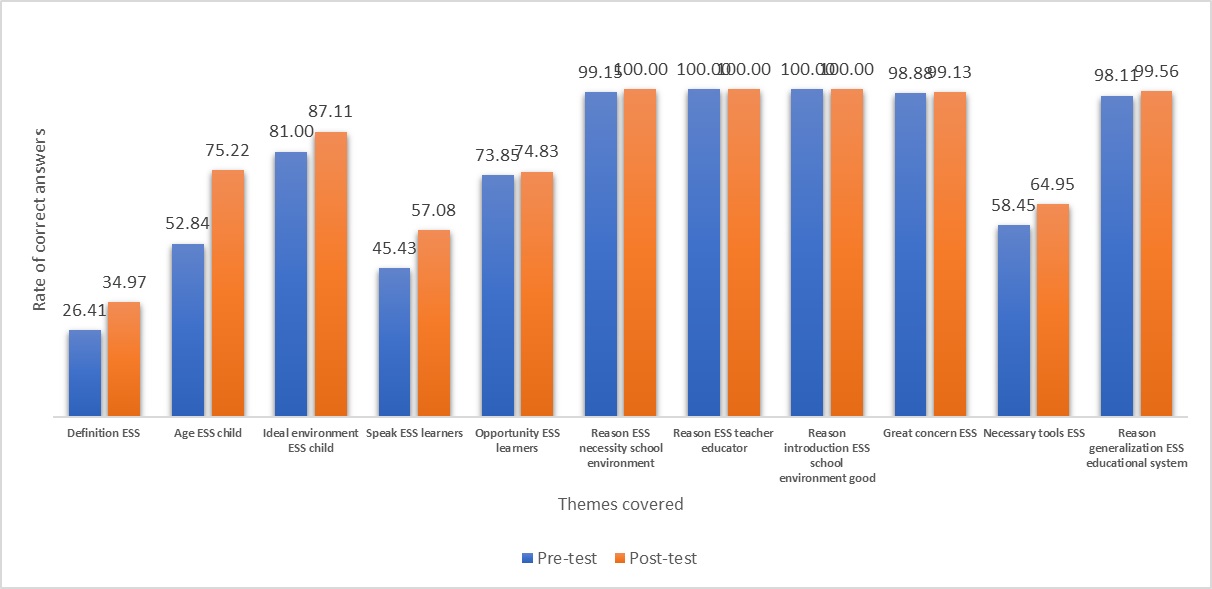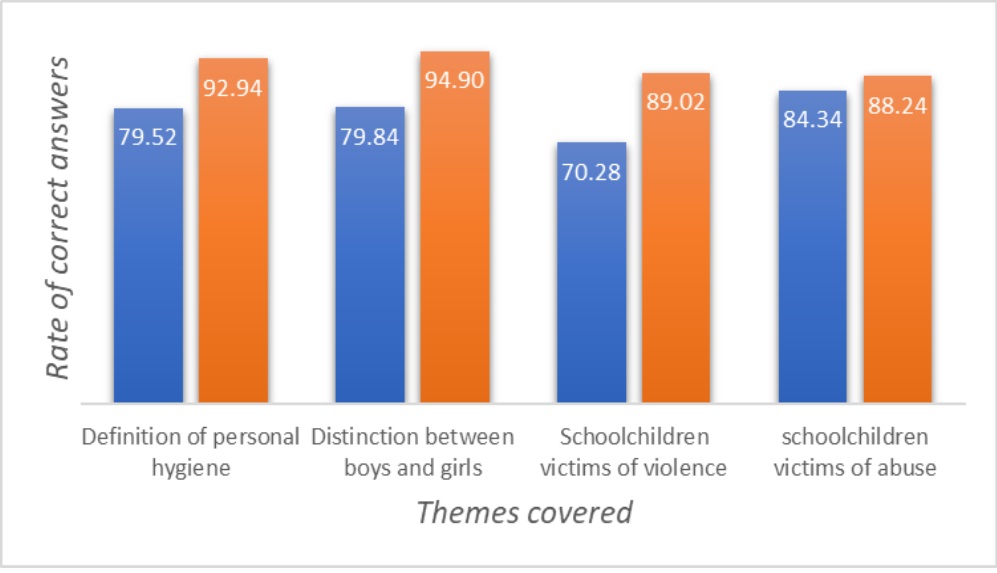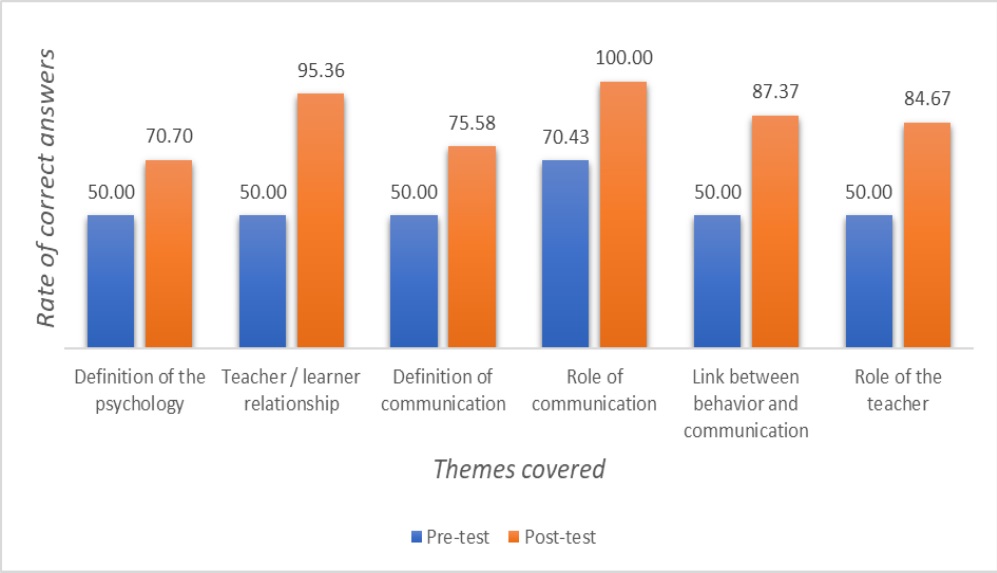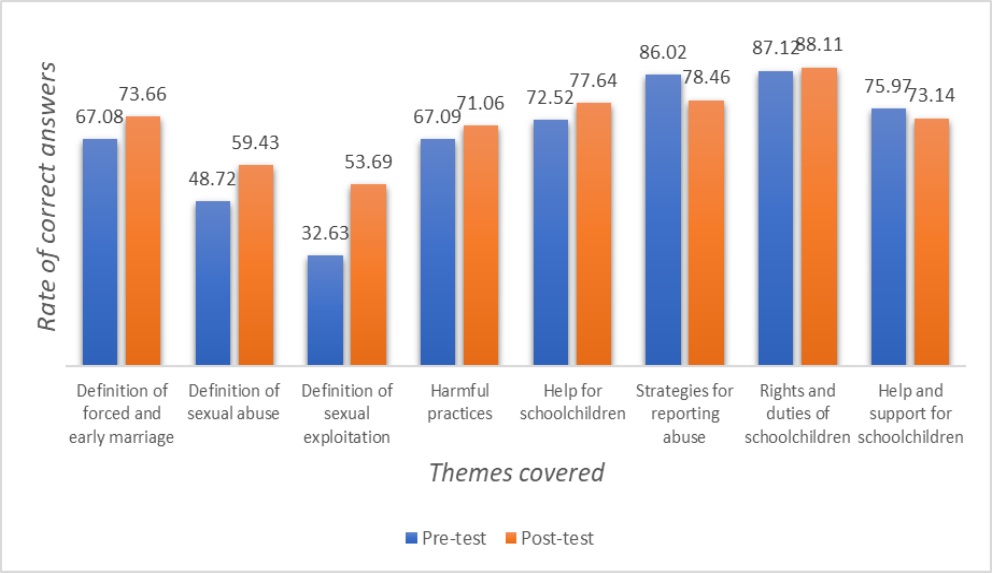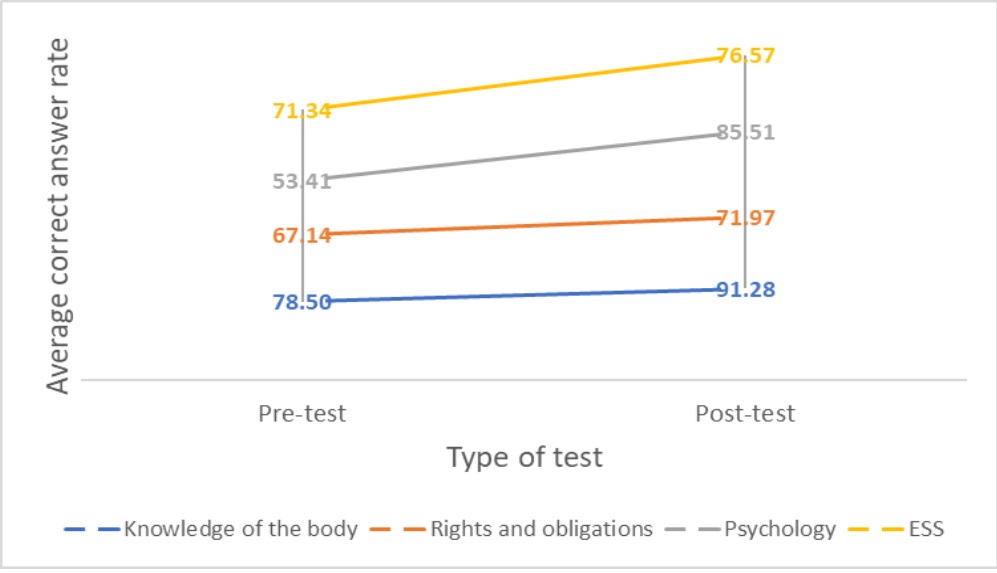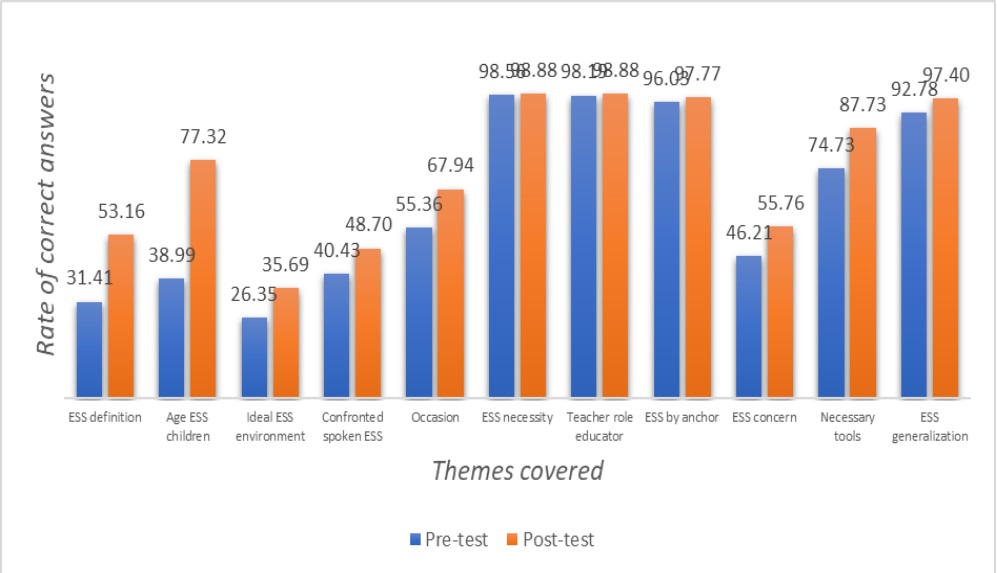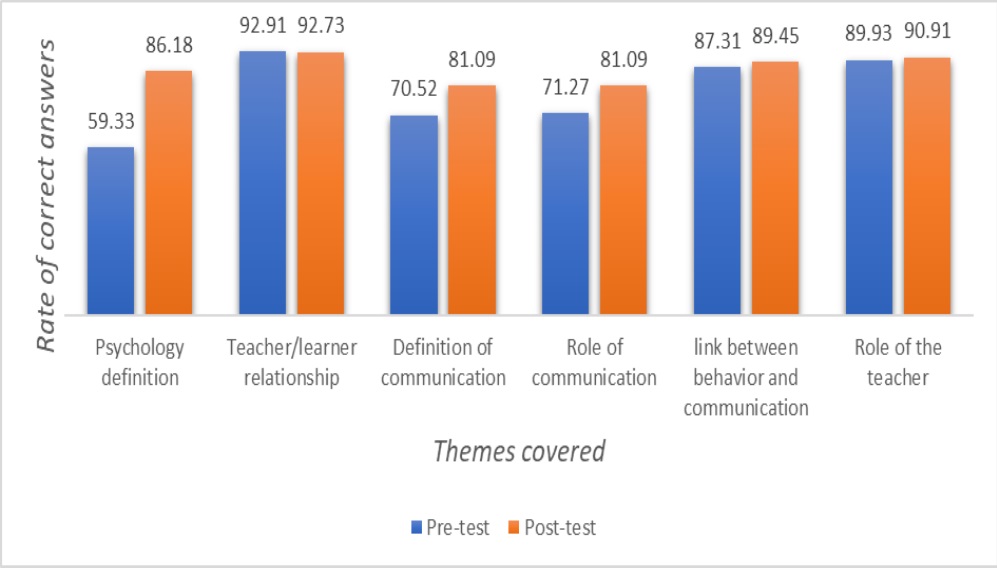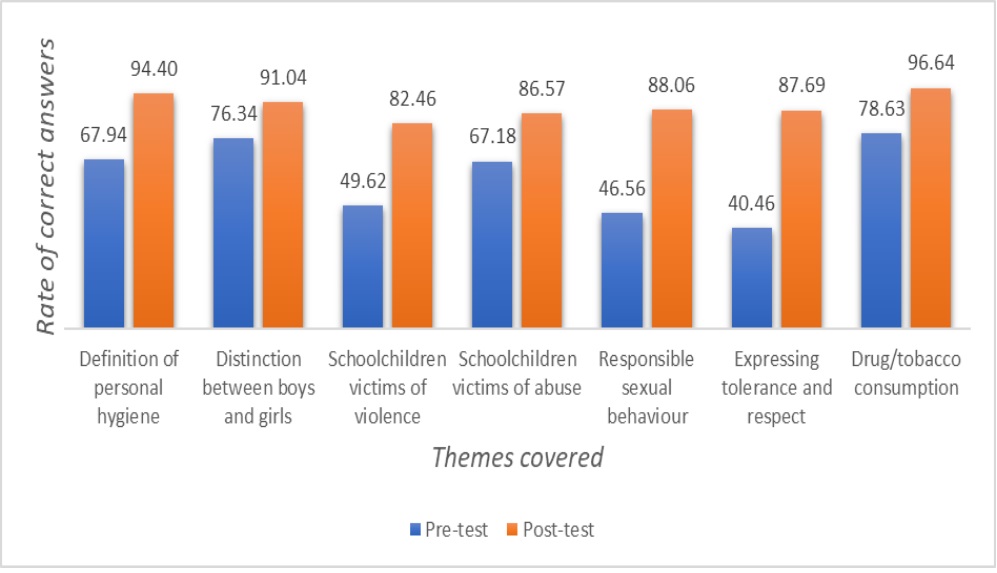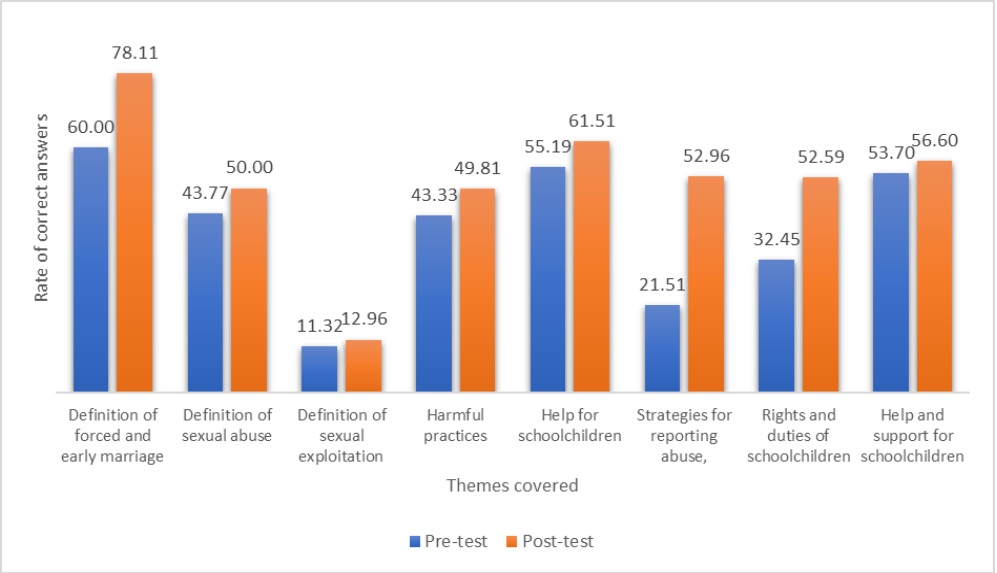Sexual Health Education in Primary Schools in Benin: Acquired Tools on Some Components of Teachers in the Municipalities of Malanville and Abomey Calavi
- Aitchedji Magloire Fortuné Landry*
- Maillard Christelle
- Kotobiodjo Blandine
- 1176-1188
- Apr 8, 2024
- Health Education
Sexual Health Education in Primary Schools in Benin: Acquired Tools on Some Components of Teachers in the Municipalities of Malanville and Abomey Calavi
Aitchedji Magloire Fortuné Landry*1, Maillard Christelle2, Kotobiodjo Blandine3
1Université Nationale des Sciences, Technologie, Ingénierie et Mathématiques (UNSTIM-Bénin)
2Association Pour l’Education, la Sexualité et la Santé en Afrique (APESSA-Bénin)
3Institut National d’Ingénierie de Formation et de Renforcement des Capacités des Formateurs (INIFRCF-Bénin)
*Corresponding author
DOI: https://dx.doi.org/10.47772/IJRISS.2024.803088
Received: 13 February 2024; Accepted: 29 February 2024; Published: 09 April 2024
ABSTRACT
The Government of Benin has chosen to strengthen sexual and reproductive health rights by integrating sexual health education into the curricula, starting at the maternal level. To this end, a capacity-building campaign for teachers has been initiated. The aim of this study is to assess the theoretical framework of knowledge for the promotion of sexual health among primary school teachers in Malanville and Abomey-Calavi, Benin. This is a descriptive cross-sectional study with analytical aims that consisted of a prospective collection of data from February 21 to 24, 2022 in Malanville on 270 teachers in the municipality of Malanville and from August 05 to 8, 2021 in Abomey-Calavi on 275 teachers in the municipality of Abomey-Calavi. Individual interviews were conducted with teachers on the basis of questionnaires on knowledge of the human body, psychology and sexual health rights and obligations. Analysis of the data reveals that in Abomey-Calavi, 71. 34% of teachers in pre-test have a mastery of knowledge of the human body compared to 76. 57% in post-test. 53. 41% in pre-test have a master’s degree in psychology compared to 85. 51% in post-test. 67. 14% in pre-test have a mastery of the right and obligation component against 71. 97% in post-test. In Malanville, on average 51. 82% of teachers have a good knowledge of children’s rights and obligations in sexual health at the end of the training. A system of monitoring and evaluation and cyclical reinforcement of trained teachers is needed to ensure lasting impacts.
Keywords: Teachers, capacity building, sexual rights, body knowledge, psychology
INTRODUCTION AND ISSUES
The World Health Organization [1] defines sexual and reproductive health (SRH) as the general well-being of the human person, both physical, mental and social, with respect to the genital system, its functions and functioning, and not only the absence of disease or infirmity. The components of SRG include, among others; the promotion of safer motherhood; family planning; the fight against Sexually Transmitted Infections (STIs) and HIV/AIDS and against Gender-Based Violence (GBV) [2]. Considered an important issue in population and development policies, SRG was the main focus of the International Conference on Population and Development (ICPD) held in Cairo in 1994 [3]. In sub-Saharan Africa, the situation of adolescent girls with regard to sexual and reproductive health and rights (SRHR) issues remains of great concern, although there is an emerging awareness of the need to better address their needs [4]. For progress on MDGs 4, 5 and 6, including in sub-Saharan Africa, it is essential to address and address the needs of all adolescent girls from an early age (10–14 years), to address sociocultural constraints and gender inequalities that limit the demand for care and counselling by adolescent girls and young women, and prevent them from accessing social rights and services. This situation, logically present in the Beninese context, is nevertheless a matter of law and justice.
At some point, all young people have to make life-changing decisions about sexual and reproductive health. However, studies show that the majority of adolescents do not have sufficient knowledge to make these decisions responsibly, leaving them vulnerable to forced sex, sexually transmitted infections and unwanted pregnancies.
According to INSAE, adolescents and young people constitute the largest segment of the population in Benin. In 2013, 52. 7% of Benin’s population was under 18 years of age [5]. This young population, both in school and out of school, faces significant sexual and reproductive health problems. The phenomenon of school pregnancies is increasing in Benin to the point where some school officials have described it as an “epidemic” [6]. Since the subject of sexuality is already taboo in Beninese culture, it is hardly discussed in society (either in the family or at school, etc.) and young people do not have the right information about good sexual practices. Unfortunately, the Beninese education system does not provide anything solid in this area, apart from a few courses in life and earth sciences (SVT), which briefly mention a chapter on human reproduction. Under these circumstances, the responsibility rests with the parents, but it is undeniable that in many families sex is still considered a taboo subject. Apart from a few awareness-raising sessions in some teaching colleges, students are usually left to their own devices. There are a number of other issues related to sexual and reproductive health and rights, such as STI/HIV/AIDS, complications related to induced abortion, sex trafficking, sexual violence, lack of knowledge and information about sexuality, lack of access to contraceptive services and commodities, abuse and ill-treatment, sexual harassment, etc. This situation will, in the long run, seriously undermine the country’s development ambitions. For this reason, the Beninese state has made the improvement of sexual and gender health conditions in schools one of its concerns.
Aware of the urgent need for action, in 2015, the Government of Benin, through the Ministry of Secondary Education (MESFTPRIJ), the Ministry of Health and the Ministry of Family and Social Affairs (MFASSNHPTA), commissioned a study on early and/or unwanted pregnancies and risky behaviors among adolescents and young people in school, vocational and university settings in Benin, public and private [7]. The study found that, in general, adolescent sexuality in Benin is characterized by risk-taking, sexual mimicry, unplanned sex, strong socio-economic influence and sometimes multiple sexual partners. Girls are the most vulnerable, with risks to their health and life, but also to their future, which in most cases is compromised by dropping out of school. This has the potential to exacerbate gender inequalities. According to the fifth Demographic and Health Survey in Benin [8], 13% of young people in Benin are sexually active before the age of 15, 20% of young girls have become pregnant before the age of 19, and 33% of unmet need for contraception among 15-19 years old. Unwanted pregnancies in school and out-of-school settings are also common, despite the existence of laws that are supposed to discourage it. These figures clearly show that many teens and young people have a real low level of knowledge about key issues related to sexuality and reproduction.
There is unanimity on the need to use a number of levers to positively influence sexual behavior and gender in schools. Sexual Health Education (SEH) could provide solutions to this precondition [9]. According to [10] is defined as a teaching and learning process based on a curriculum that addresses the cognitive, emotional, physical and social aspects of sexuality. It is therefore on the margins of the capitalization of primary school teachers in the communes of Abomey-Calavi and Malanville that this evaluation was initiated to measure their levels of knowledge before and after training.
METHODOLOGY
Nature of the study
This is a descriptive, analytical cross-sectional study consisting of a prospective collection of data from February 2022 in Malanville and August 2021 in Abomey-Calavi. Interviews were conducted with teachers on the basis of questionnaires on knowledge of Sexual Health Education (SEH), the human body, psychology and sexual health rights and obligations in pre-training and post-training.
Sampling and Data Collection
Based on the research topic, two groups of groups were targeted. These are the experimental primary teachers of the communes of Abomey-Calavi and Malanville. Before compiling our sample, we did a number of works with teachers. Indeed, it is a question of our participation in the various activities of the mechanisms. This gave us the opportunity to interview the teachers. Our sample, concerning the quantitative study, is carried out considering first all the teachers who attended during the research period from 21 to 24 February 2022 in Malanville and from 05 to 08 August 2021 in Abomey-Calavi in the various mechanisms of the Association pour l’Éducation la Sexualité et la Santé en Afrique (APESSA) of Benin. In order to obtain reliable information, we also visited some schools, where we had interviews with teachers. These various interviews give us a total of 545 teachers. After applying the selection criteria to this number of teachers, 270 teachers were selected for Malanville and 275 teachers for Abomey-Calavi. These teachers are submitted to the questionnaire of our survey during training.
Processing of Data
To study the stability of the association between the topics addressed and the rates of correct answers, a bivariate analysis of the data was made according to the municipality and the type of test. Correct response rates were calculated as well as the average rate of teachers who gave a good answer for each component taught on the basis of the data collected in order to quantitatively reproduce the results in the field. The data were analyzed with stata. The training was carried out in two phases in a school complex with a capacity of at least 10 classrooms due to compliance with the extended measures against COVID 19.
Limitations
The small size of the sample does not favor the generalization of the results at the level of the population of primary school teachers in the communes of Abomey-Calavi and Malanville. Therefore, the single use of the data collection technique by the questionnaire would be limitations related to this research work. However, we have worked to get as much information as possible. As for the reluctance of some teachers to collaborate, our participation in training activities in order to give them confidence reinforces us in the reliability of the results obtained with a view to their extrapolation to the experience of teachers in the communes of Abomey-Calavi and Malanville.
PRESENTATION AND ANALYSIS OF RESULTS
The results of the evaluation are presented by sector. In each sector, the four strands were addressed by commune.
Municipality of Abomey-Calavi (Calavi School District 1 and 3)
Sexual health education for primary teachers
Figure 1: Level of knowledge of teachers on sexual health education
Source: APESSA (2021-2022) [18]
With an average gain in knowledge of 5. 23 points, all the topics covered in the sexual health education component were understood by the teachers. 34. 97% of the trained teachers answered in the post-test that the ESS means accompanying the learners to the knowledge and control of their bodies and to talk about friendly, emotional, romantic and sexual relationships with the children, compared to 26. 41% in the pre-test. 75. 22% of trained teachers say that it is possible to talk about ESS to a child from 3 years of age, compared to 52. 84% in the pre-test. It is the theme with the highest gain in awareness with 22. 38 points of difference. So, there is a need to talk about sexual health education to a child from an early age. 87. 11% of trained teachers indicated in the post-test that the ideal environment for children to learn their first sexual health concepts is school, compared to 81% in the pre-test [11]. This result. 57. 08% of the trained teachers stated in the post-test that they were confronted with discussing sexual health with the learners compared to 45. 43% in the pre-test. 74. 83% of trained teachers say they talk about sexual health in class sequences compared to 73. 85% in pre-test. This type of intervention must be exposed in the community, especially to the holders of the tradition, because issues related to sexuality remain taboo in some localities, as stated by [12]. 100% of the trained teachers state in a post-test that the ESS helps to save the Beninese school by reducing early pregnancies, STIs and HIV. The learners master their bodies against 99. 15% in the pre-test. 100% of the teachers affirm in the post-test that the teacher is an educator, a role model for the learners against 100% in the pre-test. 64. 95% of trained teachers stated in the post-test that they need training and documentation compared to 58. 45% in the pre-test. Trained teachers expressed a need for training and documentation in ESS. 99. 56% of trained teachers say that ESS should be generalized in the education system, compared to 98. 11% in the pre-test. The ESS must therefore be integrated into the education system. 99. 13% of teachers who have been trained in the post-test state that their main concern is to find themselves answering annoying questions, compared to 98. 8% in the pre-test.
Body knowledge among elementary teachers
Figure 2: Level of knowledge of teachers on the control of the human body
Source: APESSA (2021-2022) [18]
In this component, teachers have improved their knowledge levels. Thus, at the end of the training, 92. 94% of teachers trained in primary school state that body hygiene is all care aimed at the cleanliness of the body, compared to 79. 52% in the pre-test. 94. 9% of trained teachers answered in the post-test that the difference between boys and girls can be explained by gender differences compared to 79. 84% in the pre-test. 89. 02% of the trained teachers answered in the post-test that a student who has been sexually abused shows self-absorption, compared to 70. 282% in the pre-test. 88. 24% of the trained teachers stated in the post-test that a student who has suffered abuse is recognized by the presence of multiple injuries, compared to 84. 34% in the pre-test. This hypothesis is confirmed by [13]. Interpretation of the results shows that teachers have generally improved their knowledge levels in this area with a good margin for progress. Overall, these results show that the majority (91. 27%) of trained teachers now have a good knowledge of the body knowledge component of ESS at the end of their training.
Psychology in primary school teachers
Figure 3: Level of knowledge of psychology among teachers
Source: APESSA (2021-2022) [18]
The pre- and post-test results of the psychology component of primary school teachers show some improvement in their knowledge. 70. 07% of the trained teachers answered in the post-test that psychology is a science of behavior and that of states of consciousness, compared to 50% in the pre-test. 95. 36% of trained teachers answered in the post-test that the importance of psychology is to achieve better academic performance compared to 50% in the pre-test. 75. 58% of trained teachers stated in the post-test that communicating means talking to each other without judging by listening attentively, compared to 50% in the pre-test. At the end of the training, 100% of the trained teachers answered that communication helps to establish a better teacher-teacher relationship compared to 70. 43% in the pre-test [14]. 87. 37% of the trained teachers answered in the post-test that the link between communication and behavior is as much as it is impossible not to have behavior, as it is not possible not to communicate, compared to 50% in the pre-test. 84. 67% of the trained teachers state in the post-test that the teacher’s role is to guide the learner to discover their body and part of their sexuality, compared to 50% in the pre-test.
Rights and obligations of children among primary school teachers
Figure 4: Level of awareness of teachers about rights and obligation
Source: APESSA (2021-2022) [18]
At the end of the training, 73. 66% of the trained teachers state that forced marriage is a union between a man and a woman without the consent of one or both persons, compared to 67. 08% in the pre-test. 59. 43% of the trained teachers answered in the post-test that sexual abuse is any intrusion of a sexual nature committed by force or in favor of an unequal relationship or the threat of intrusion on a person, compared to 48. 72% in the pre-test. 53. 69% of trained teachers answered in the post-test that child sexual exploitation is the use of children in pornographic activities and scenes or publications, compared to 32. 63% in the pre-test [15]. After training, 71. 6% of trained teachers state that female genital mutilation is a harmful practice compared to 67. 09% in pre-test de [16]. 77. 64% of trained teachers stated in the post-test that listening, assistance (in the form of psychosocial medical services based on trust, respect and non-discrimination) compared to 72. 52% in the pre-test. 78. 46% of the trained teachers answered in the post-test that one strategy for reporting is to go to a police station or the nearest social promotion center. This stagnation in the level of knowledge could be explained by a lack of confidence in other actors. However, they learned during the training that referring to their superior and calling one of the toll-free numbers are among other means of denunciation. Since police stations and social development centers are closer, teachers are spontaneously drawn to them. More than three quarters (88. 11%) of trained teachers answered in the post-test that a child can become aware of his/her rights and duties through education in children’s rights, compared with 87. 12% in the pre-test. 73. 14% of the trained teachers answered in the post-test that the pupil can get help in the event of difficulty by confiding in a trusted person, compared to 75. 97% in the pre-test. The decrease is reportedly due to the rapid completion of the questionnaire at the end of the sessions, as everyone is in a hurry to travel the many kilometers required before reaching their families. The interpretation of the results obtained in the pre- and post-tests of rights and obligations by primary school teachers shows an improvement, even if, taking the example of whistleblowing strategies, some teachers are reluctant to depart from their original conception of certain concepts. They believe that laws change traditions [17]. For the most part, the concept of sexuality is a physiological need, and its fulfillment cannot be hindered. By deduction, on average 71. 96% of trained primary school teachers have a good understanding of children’s sexual health rights and obligations at the end of their training.
Study of trends
Figure 5: Knowledge acquired at the primary school in Abomey-Calavi
Source: APESSA (2021-2022) [18]
In Abomey-Calavi, 71. 34% of teachers in pre-test have a mastery of ESS tools compared to 76. 57% in post-test. 53. 41% in pre-test have a master’s degree in psychology compared to 85. 51% in post-test. 67. 14% in pre-test have a mastery of the right and obligation component against 71. 97% in posttest. Finally, 78. 50% in pre-test have a mastery of body knowledge compared to 91. 28% in post-test. As a result, the majority of teachers had a maximum level of mastery of the various components covered. Others who did not master the issues learned new knowledge. There are 59. 43% new teachers in knowledge of the body, 14;58% in rights and obligations, 68. 90% in psychology and 18. 26% in ESS.
In order to achieve the objective of 100% acquired knowledge, 40. 57% of teachers still need to be trained in knowledge of the body; 85. 32% in rights and obligations; 31. 10% in psychology and 81. 74% in ESS.
Municipality of Malanville
Sexual health education for primary teachers
Figure 6: Level of knowledge of teachers on sexual health education
Source: APESSA (2021-2022) [18]
With an average gain in knowledge of 10. 92 points, all the topics covered in the sexual health education component were understood by the teachers. 53. 16% of the trained teachers answered in the post-test that the ESS means accompanying children to the knowledge and control of their bodies and to talk about friendly, emotional, romantic and sexual relationships with children, compared to 31. 41% in the pre-test. 77. 32% of trained teachers say that it is possible to talk about the ESS to a child from the age of 3 years, compared to 38. 99% in the pre-test. 35. 69% of the trained teachers indicated in the post-test that the ideal environment for the child to receive their first knowledge of sexual health is school, compared to 26. 35% in the pre-test. 48. 70% of the trained teachers stated in the post-test that they were confronted with discussing sexual health with the learners compared to 40. 43% in the pre-test. 67. 94% of trained teachers say they talk about sexual health in class sequences compared to 55. 36% in pre-test. 98. 88% of the trained teachers state in the post-test that the ESS helps to save the Beninese school by reducing early pregnancies, STIs, HIV, and learners will control their bodies, compared to 98. 56% in the pre-test. 98. 88% of teachers state in the post-test that the teacher is an educator, a role model for learners compared to 98. 19% in the pre-test. 97. 77% of trained teachers state in post-test that they need training and documentation compared to 96. 03% in pre-test. Trained teachers expressed a need for training and documentation in ESS. 55. 76% of trained teachers say that ESS should be generalized in the education system, compared to 46. 21% in the pre-test. Thus, ESS is essential for the education system [10]. 87. 73% of trained teachers stated in the post-test that the introduction of ESS into education is a good strategy, compared to 74. 73% in the pre-test. 97. 40% of trained teachers state in the post-test that their main concern is to find themselves answering annoying questions compared to 92. 78% in the pre-test.
Psychology in Primary School Teachers
Figure 7: Level of knowledge of psychology among teachers
Source: APESSA (2021-2022) [18]
86.18% of trained teachers answered in the post-test that psychology is a science of behavior and that of states of consciousness, compared to 59. 33% in the pre-test. 92. 73% of trained teachers answered in the post-test that the importance of psychology is to achieve better academic performance compared to 92. 93% in the pre-test. 81. 09% of trained teachers state in post-test that communicating means talking to others without judging by listening carefully, compared to 70. 52% in pre-test. At the end of the training, 81. 09% of the trained teachers answered that communication helps to establish a better teacher/teacher relationship compared to 71. 27% in the pre-test. 89. 45% of the trained teachers answered in the post-test that the link between communication and behavior is as much as it is impossible not to have behavior, as it is not possible not to communicate, compared to 87. 31% in the pre-test. 90. 91% of the trained teachers stated in the post test that the teacher’s role is to guide the learner to discover their body and part of their sexuality compared to 89. 93% in the pre-test. Pre- and post-test results for primary school teachers show a more or less constant margin of progression. The decrease in the theme “Importance of the teacher-learner relationship” would be due to a lack of understanding of the concept and/or the speed with which the questionnaire was completed. From its results, it can be deduced that on average 86. 91% of trained primary school teachers have a good knowledge of the psychology component of ESS. As a result, teachers have improved their level of knowledge in psychology.
Body Knowledge among Elementary Teachers
Figure 8: Level of knowledge of teachers on the control of the human body
Source: APESSA (2021-2022) [18]
At the end of the training, 94. 40% of the trained teachers (primary level) say that body hygiene is all care aimed at the cleanliness of the body, compared to 67. 94% in the pre-test. 91. 04% of trained teachers (primary level) answered in the post-test that the difference between boys and girls can be explained by gender differences compared to 76. 34% in the pre-test. 82. 46% of trained teachers (primary level) answered in the post-test that a schoolchild who has been sexually abused shows self-absorption, compared to 49. 62% in the pre-test. 86. 57% of trained teachers (primary level) say in the post-test that a schoolchild who has suffered abuse is recognized by the presence of multiple injuries, compared to 67. 18% in the pre-test. 88. 06% of trained teachers (primary level) stated in a post-test that a pupil can demonstrate responsible sexual behavior by using condoms during sexual intercourse, compared with 49. 56% in a pre-test. 87. 69% of trained teachers (primary level) say in the post-test that a pupil can express tolerance and respect by respecting their teachers and peers, compared to 40. 46 in the pre-test. 96. 64% of trained teachers (primary level) say in a post-test that a school pupil can learn about the consequences of drug/tobacco use by attending CEI sessions, compared to 78. 63%. The results show that teachers have generally improved their knowledge levels in this area with a good margin for progress. In deduction, its results show that 89. 55% of trained primary school teachers now have a good knowledge of the body knowledge component of ESS at the end of their training.
Rights and obligations of children among primary school teachers
Figure 9: Level of awareness of teachers about rights and obligations
Source: APESSA (2021-2022) [18]
After training 78. 11% of trained teachers state that forced marriage is a union between a man and a woman without the consent of one or both persons, compared to 60% in the pre-test. 50% of the trained teachers answered in the post-test that sexual abuse is any intrusion of a sexual nature committed by force or in favor of an unequal relationship or the threat of intrusion on a person, compared to 43. 77% in the pre-test. 12. 96% of the trained teachers answered in the post-test that the sexual exploitation of children is the use of children in pornographic activities and scenes or publications, compared to 11. 32% in the pre-test. This concept is partly understood by teachers. Nevertheless, there is the persistence of cultural values. However, they were apprehensive that this was an act punishable by law. At the end of the training, 49. 81% of the trained teachers state that genital mutilation is harmful, compared to 43. 33% in the pre-test. 61. 51% of trained teachers stated in the post-test that listening, assistance (in the form of psychosocial medical services based on trust, respect and non-discrimination) compared to 55. 19% in the pre-test. 52. 96% of the trained teachers answered in the post-test that one strategy for reporting is to go to a police station or the nearest social promotion center. This level of knowledge could be explained by the lack of added value after exposing the various topics covered. However, they learned during the training that referring to their superior and calling one of the toll-free numbers are among other means of denunciation. Since police stations and social development centers are closer, teachers are spontaneously drawn to them. Also, some teachers do not trust their hierarchy, let alone the Social Promotion Centers. They believe that the CPS are limited in their means of action and that the hierarchical superior may mislead them or, for the sake of settling scores, mismanage cases submitted to them. So, they prefer not to take risks. 52. 59% of trained teachers answered in the post-test that a child can become aware of his/her rights and duties through education in children’s rights, compared to 32. 45% in the pre-test. 56. 60% of the trained teachers answered in the post-test that the student in difficulty can get help in the event of difficulty by confiding in a trusted person, compared to 53. 70% in the pre-test. On average, 51. 82% of trained primary school teachers have a good understanding of children’s sexual health rights and obligations at the end of their training.
ANALYSIS OF RESULTS
Indeed, the results show that the training of primary school teachers in Abomey-Calavi and Malanville has been a success. Teachers were trained on the various aspects of ESS, such as: ESS tools, psychology, body knowledge, rights and obligations in ESS. However, the analysis of the results revealed some confusion in the answers, which could only be due to the eagerness of the teachers to fill out the forms during the post tests. These results indicate that trained teachers need a cyclical reinforcement of the ESS with supporting documentation.
A first analysis is necessary: it is mainly on the basis of social representations and individual conceptions that the answers of the interviewees differ. It is the conceptions and representations of sexuality education that most differentiate the communes, with more traditional positions opposing the introduction of important issues of sexuality education, particularly in terms of prevention, in the commune of Malanville, and opposing more open positions, more rooted in the reality of sexual practices in the commune of Abomey-Calavi.
A second analysis concerns perceptions of teaching practices. They differ significantly from municipality to municipality, as well as from sample category to sample category. These differences deserve to be interpreted on the basis of complementary analyses, for example separating health education from rights and obligations. Some of them suggest a generational effect, especially in the field of sexuality education, as young people are more likely to address sexuality issues in the fight against AIDS. Other differences emerge from these analyses, showing the complexity of teachers’ perceptions of their teaching practices in these areas. It is not only a matter of informing him, but also of being able to be psychologically and physiologically able to acquire power on his own, on his environment.
CONCLUSION
In short, health education contributes to the construction of the teacher, the learner and the citizen. It is about teaching scientific knowledge and at the same time encouraging thoughtful behavior that takes the person into account and makes them responsible for their life. This study, which we wanted to be descriptive, highlights significant differences in conceptions among trained teachers from the two municipalities. These conceptions, which differ significantly from teachers from one municipality to another, are very subject to the impact of religion, but this influence fades when the level of initial academic training increases. Raising the level of teacher training promotes the promotion of better citizenship and appears to be one of the ways of combating ideas that increase social and gender inequalities.
BIBLIOGRAPHIC REFERENCES
- Le Pennec, A. (2013). Santé sexuelle, la définition. Organisation Mondiale de la Santé ; Dans L’école des parents2013/3 (N° 602), page 37.
- Giami, A. (2007). Santé sexuelle : la médicalisation de la sexualité et du bien-être. Le Journal des psychologues, 250, 56-60. https://doi.org/10.3917/jdp.250.0056.
- Pelchat, Y. (1995). La Conférence internationale sur la population et le développement du Caire : un parti pris pour les femmes. Recherches féministes, 8(1), 155–164. https://doi.org/10.7202/057825ar.
- UNFPA (2017). Santé et droits sexuels et de la procréation des adolescent(e)s au Mali : Analyse des politiques et des programmes : opportunités et défis pour l’UNFPA. En ligne sur https://equipop.org/publications/Rapport%20-ados-Mali-UNFPA.pdf. Consulté le 10/02/2024.
- INSAE (2014). Enquête par grappes à indicateurs multiples (MICS) Fonds des Nations Unies pour l’Enfance ; cotonou@unicef.org ; Institut National de la Statistique et de l’Analyse Économique.
- Gbaguidi, T. (2017). Grossesses en milieu scolaire dans l’arrondissement de Tchaourou (Bénin) : niveau, profil des femmes concernées et conséquences en matière de scolarisation. En signe sur : https://scienceetbiencommun.pressbooks.pub/tchaourou/chapter/grossesses-en-milieu-scolaire-dans-larrondissement-de-tchaourou-benin-niveau-profil-des-femmes-concernees-et-consequences-en-matiere-de-scolarisation/. Consulté le 12/02/2024.
- EMICoV-(2015). Rapport Préliminaire. Institut National de la Statistique et de l’Analyse Economique (INSAE). Enquête Modulaire Intégrée sur les Conditions de Vie des Ménages, 3ème édition.
- EDSB-V (2017-2018). Cinquième Enquête Démographique et de Santé au Bénin. Ministère du Plan et du Développement Institut National de la Statistique et de l’Analyse Économique (INSAE) Cotonou, Bénin développement du secteur de l’éducation, Équipe Nationale du Bénin, UNESCO – IIPE Pôle de Dakar, 2014.
- Nayak, L. (2013). Une logique de promotion de la « santé sexuelle. L’assistance sexuelle en Suisse. Ethnologie française, 43, 461-468. https://doi.org/10.3917/ethn.133.0461
- UNESCO, (2014). Rapport d’état du système éducatif béninois, Pour une revitalisation de la politique éducative dans le cadre du programme décennal de développement du secteur de l’éducation.
- Berger, D. & al. (2011). Education à la santé et à la sexualité : qu’en pensent les enseignants ? Étude comparative dans 15 pays. Dans Carrefours de l’éducation2011/2 (n° 32), pages 81 à 103.
- Lehodey M-N (2017). La sexualité, un sujet tabou pour la médiation familiale ? Dans Tiers 2017/2(N°20), p. 19-27.
- Tursz A. (2015). La maltraitance envers les enfants. Dans les Cahiers Dynamiques 2015/4
- Haiat, S. (2023). La relation enseignant-élève au cœur de la réussite éducative. Les Cahiers de CERFEE. Open Edition Journals.
- Wattier I. (2006). La lutte contre l’exploitation sexuelle des enfants et la pédopornographie et la majorité sexuelle La consécration d’une disparité. Dans Revue internationale de droit pénal. 2006/1-2 (Vol. 77), pages 223 à 235.
- Andro, A., Lesclingand, M. (2017). Les mutilations génitales féminines dans le monde. Dans Population & Sociétés 2017/4 (N° 543), pages 1 à 4.
- Yssalys, P. (1992). Les Cahiers de droit La loi dans le droit: tradition, critique et transformation Volume 33, numéro 3, Éditeur(s) Faculté de droit de l’Université Laval.
- APESSA (2021-2022). Analyse des données de la formation des enseignant(e)s sur l’Education à la Santé Sexuelle dans les communes de Malanville et d’Abomey-CALAVI. Appui UNFPA, Cotonou-Bénin.

